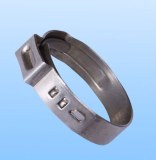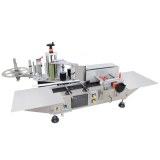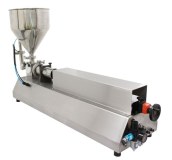CNC MACHINING PARTS
CNC (Computer Numerical Control) machining is a subtractive manufacturing process that uses computerized machine tools to make a custom-designed part. A computer uses programming codes to direct machine tools to chip at (subtract) a material. This is until the material forms the input designed part.
With the use of a wide range of materials such as metals, plastics, and composites, CNC machining can produce parts with excellent mechanical properties, durability, and corrosion resistance, making them suitable for various applications.
Advantages of China CNC Parts Machining
High precision and accuracy: With CNC machining, parts can be manufactured with extremely tight tolerances and high accuracy, providing a level of consistency that is difficult to achieve with manual machining processes.
Wide range of materials: CNC machining can be used with a variety of materials, including metal, plastic, wood, and composites.
Cost-effective for high-volume production: CNC machining is ideal for high-volume manufacturing as it enables the production of large quantities of parts at a lower cost per piece.
Increased efficiency: The automated nature of CNC machining means that production can be carried out more efficiently, without the need for manual intervention, resulting in faster production times.
Versatility: CNC machining can be used to produce complex components with intricate shapes and geometries, making it suitable for a wide range of applications.
Exploring the World of China CNC Machining Prototype Service: A Look at Different Types
In the realm of precision manufacturing, Computer Numerical Control (CNC) machining stands as a technological marvel that has revolutionized the production industry. CNC machining involves the use of computerized systems to control machine tools and processes, allowing for highly accurate and efficient production of intricate parts and components. The various CNC machining processes under HHC have different application scopes and processing characteristics. The following provides a detailed classification and introduction.
1. Milling:
One of the most common types of CNC machining, milling employs rotating cutting tools to remove material from a workpiece. The milling machine can move along multiple axes, creating a wide range of shapes, slots, and holes. From simple components to complex prototypes, milling is versatile and widely used in industries like aerospace, automotive, and electronics.
2. Turning:
In turning operations, the workpiece rotates while a cutting tool shapes it into the desired form. This type of CNC machining is ideal for creating cylindrical components such as shafts, bolts, and spindles. Precision turning is a cornerstone of manufacturing processes, providing efficiency and accuracy for various applications.
3. Drilling:
As the name suggests, drilling CNC machines are designed to create holes in workpieces. These machines use rotating drill bits to remove material, and they are crucial in the production of components that require precise and uniform holes. Industries like construction, metalworking, and electronics heavily rely on CNC drilling for their manufacturing needs.
4. Grinding:
When extreme precision and surface finish are paramount, CNC grinding comes into play. This method employs abrasive wheels to remove material and achieve tight tolerances. CNC grinding is indispensable in the production of tools, molds, and high-precision components used in medical devices and aerospace engineering.
5. Electrical Discharge Machining (EDM):
EDM is a non-traditional CNC machining method that utilizes electrical discharges to shape materials. By carefully controlled electrical sparks, EDM can create intricate and complex shapes with high precision. This technique is particularly useful for hard metals that are challenging to machine with traditional methods. For example, we use Electrical Discharge Machining (EDM) to customize templates for molds
6. Laser Cutting:
CNC laser cutting involves the use of a laser beam to cut through materials, creating precise and clean edges. This method is widely used in the fabrication of sheet metal components for industries ranging from automotive to consumer electronics. The high level of precision and speed makes CNC laser cutting an invaluable process in modern manufacturing.
CNC Machining vs 3D Printing: Unveiling the Differences
In the ever-evolving landscape of manufacturing, two cutting-edge technologies have emerged as frontrunners: CNC machining and 3D printing. Each method brings its own set of strengths and applications to the table. Let's delve into the intricacies of CNC machining and 3D printing, comparing their features, advantages, and limitations.
CNC (Computer Numerical Control) machining is a subtractive manufacturing process. It involves removing material from a workpiece to achieve the desired shape. This process utilizes computer-aided design (CAD) and computer-aided manufacturing (CAM) software to precisely control the movement of cutting tools.
CNC machining is renowned for its high level of accuracy and precision. It can achieve tight tolerances and produce intricate details, making it suitable for applications where precision is paramount, such as aerospace and medical industries. CNC machining is versatile when it comes to material compatibility. It can handle a wide range of materials, including metals, plastics, and composites. This makes it a preferred choice for industries demanding durability and strength in their components. CNC machining is well-suited for both prototyping and large-scale production. While the setup time for CNC machining can be longer than 3D printing, it excels in producing high-quality, functional parts. CNC machining provides a superior surface finish compared to many 3D printing technologies. This makes it an ideal choice for components requiring a polished or smooth surface.
2. Transforming Ideas into Reality
3D printing, or additive manufacturing, builds objects layer by layer from a digital model. It involves depositing material in a specific pattern to create a three-dimensional object. This process is highly versatile and allows for intricate geometries.
3D printing supports a diverse range of materials, including plastics, metals, ceramics, and even bio-materials. The material choices continue to expand, opening up new possibilities for various industries. 3D printing excels in rapid prototyping and is well-suited for complex geometries that may be challenging for CNC machining. However, it may not match the speed of CNC machining for large-scale production. In terms of cost-effectiveness, especially for low-volume production and prototyping, 3D printing can offer advantages due to reduced material wastage and simpler setups. 3D printing is celebrated for its customization capabilities. It allows for the creation of unique, personalized designs without the need for additional tooling, making it ideal for one-off or small-batch production.
Overall, the choice between CNC machining and 3D printing depends on factors such as materials, precision requirements, production scale, and project complexity. For larger production runs, CNC machining excels in precision and material versatility, while 3D printing shines in rapid prototyping and complex design applications.
As one of china cnc machining service manufacturers, we will do our best to meet all the needs of customer.
There are many precision components suppliers in China, but we are one of the best choices for you.
Persona a contactar : precision hhc, 0755 81781342
Buen trato: comprar del vendedor
Por favor, lea nuestras condiciones de uso. También puede visitar nuestras preguntas frecuentes y ver nuestra información sobre los riesgos relacionados con la falsificación.
|
Esta página es acerca de los importadores y exportadores de CNC MACHINING PARTS Buscar en la categoria : B2B Servicios Buscar en la categoria : machining, parts |
Tuesday 23 December 2025
Cantidad : 500 - Precio : USD0.5/pc
American Pinch clamps Factory in China The Supplier of one of Fortune top 500 Machine, Technology, Quality from USA SAE Type SEC Stainless Steel Single Ear Pinch Clamps KSL7123 Beverage, automotive, marine, motorcycle and industrial pinch clamps. The patented 300 Series Stainless...
King Seal Fastener Technology(Anhui) Co., Ltd.
- 233010 - Bengbu
- 86 552 4193229
Tuesday 23 December 2025
Cantidad : 1 set
- Tabletop Round Bottle Labeling Machine - Model No.: LR-100 Tabletop Round Bottle Labeling Machine LR-100 is a tabletop labeling machine for round labeling or side labeling. A durable but portable machine provides efficiency at minimum costs. FEATURES: - Stepper Motor for fast and...
Autopack Co.,Ltd
- autopacker
- 33454 - Taoyuan City
- +88 6 33 68 98 06
Tuesday 23 December 2025
Model No.: FP-150 Tabletop Pneumatic Piston Liquid Filling Machine FP150 is suitablely applied on sticky liquids such as shampoo, hand washing and dish soap. Furthermore, the Liquid Filling Machine also could be used for sticky foods such as honey, syrup, ... etc. The pneumatic...
Autopack Co.,Ltd
- autopacker
- 33454 - Taoyuan City
- +88 6 33 68 98 06










